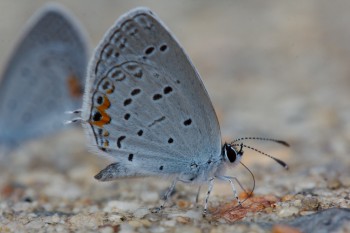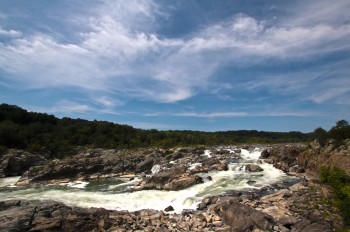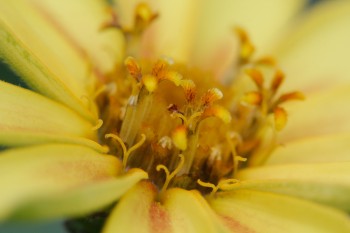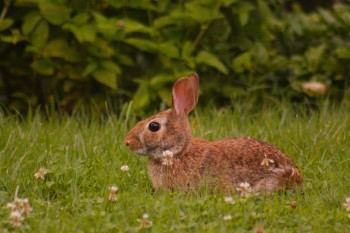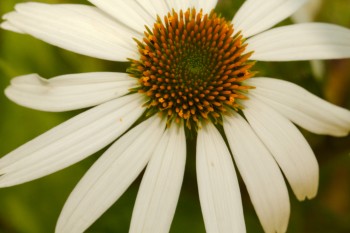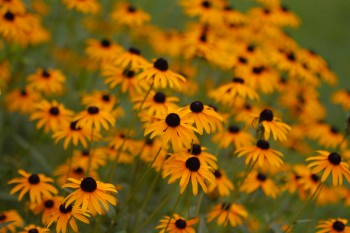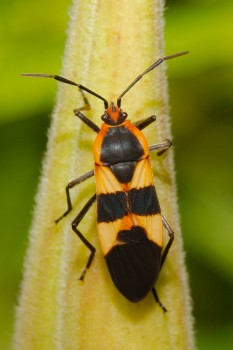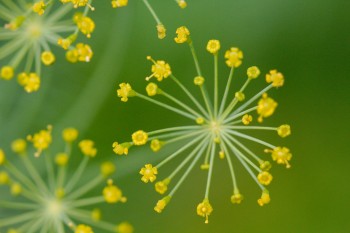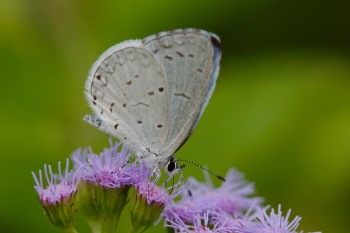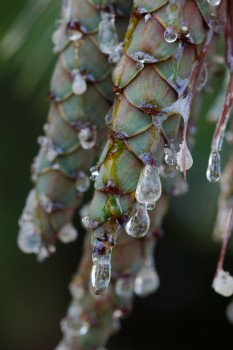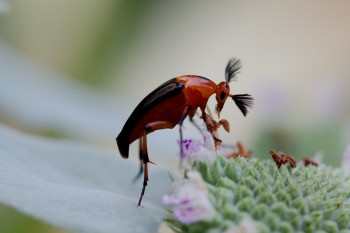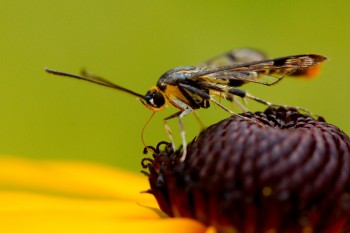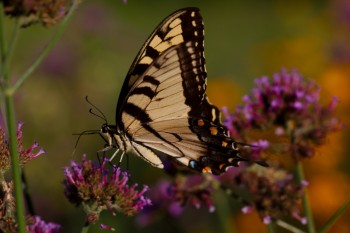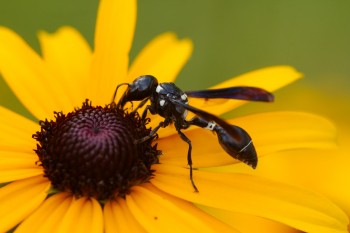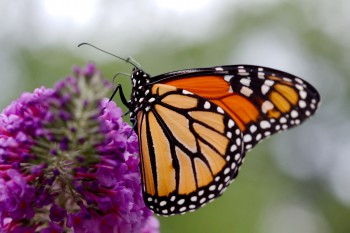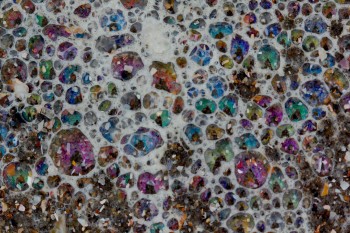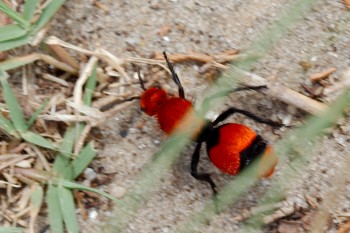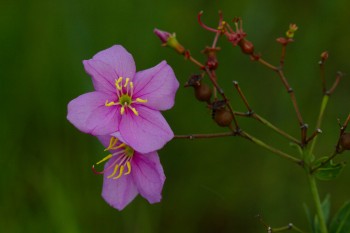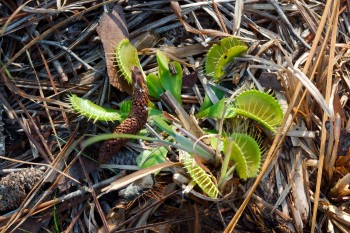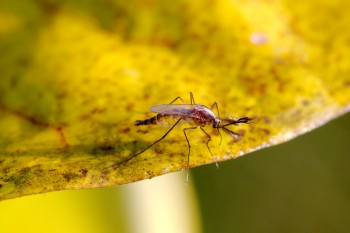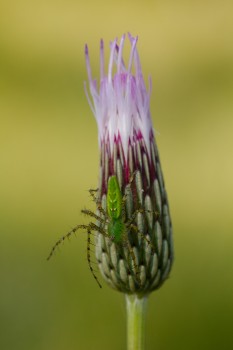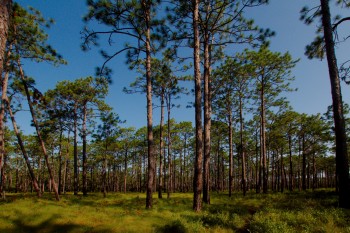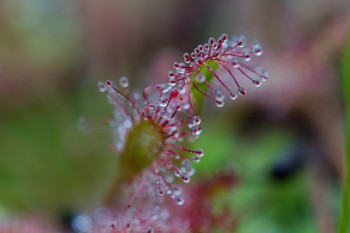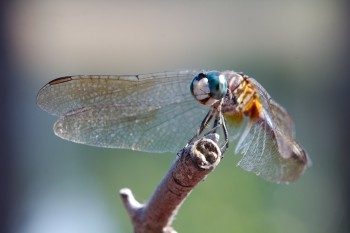The youth group had a pool party this afternoon and we couldn’t have had better weather. It was warm but not too hot, the sky was a beautiful blue with a few clouds, and the water was cool and refreshing. I took a lot of pictures but the one I’m going to share with you all is a butterfly. There was a little cloud of these, four or five, fluttering around an shady spot where water had been splashed onto the concrete around the pool. They are quite small, not much more than about one centimeter tall (about 3/8 of an inch).
Cupido comyntas (Eastern Tailed-Blue)
Great Falls, Maryland
It felt like fall today, starting out in the upper 60s and only getting into the low 80s, with relative humidity levels below 50%. We went to Great Falls today and were not at all surprised by the number of people there. We walked to the overlook on Olmsted Island. The water level is pretty low, but that’s usual this time of year. In fact, it’s probably not as low as many years this late in the summer.
Zinnia Flower Detail
Zinnia flowers are interesting. As members of the aster or sunflower family (Asteraceae or Compositae), they have composite flowers—flowers made up of many little flowers. There are actually two different types of flowers on each single” zinnia flower. Around the outside are ray flowers which have, in the case of the flower shown here, a single petal. Sometimes they have multiple petals, making the overall compound flower “double.” Then, in the center of the compound flower are disk flowers. In the picture here, these disk flowers have orange in their corolla lobes. The little question mark filaments at the base of the ray flowers are their stigmata.
Eastern Cottontail Rabbit (Sylvilagus floridanus)
With the fox that we had in our yard over the winter, I had hoped that we’d have fewer rabbits this summer. Cathy saw the fox this week, so it’s still around, but we’ve had as many rabbits as ever. Of course, for all I know, we’d have twice as many if the fox were not around. Anyway, this fellow (or lady, I don’t know) was sitting out in our back yard, happy as you please, this afternoon when I came home. The grass is lush this summer and they haven’t done as much damage to our garden as in some years, because of that, but I still wouldn’t mind having fewer of them.
They are cute, though. That’s something in their favor.
White Coneflower
We’ve had an amazing summer. After a rather cold and gloomy winter, which ran over into spring, we’ve had a particularly mild summer. There have been a few hot spells into the 90s, but for the most part it has been quite lovely.
Normally by this time of the summer, the grass in the lawn would be partially brown and the flowers, even the black-eyed Susans and coneflower (Echinacea species), would be bug eaten and starting to dry up. This week, leading up to the middle of August, has been particularly spectacular. The high temperatures have been in the mid 80s and it has been relatively dry, in terms of humidity. And, we’ve had plenty of rain. In extreme years we go most or even all of July and August without a shower.
Black-eyed Susans
No insects today, just flowers. This is the predominant color in our back yard right now. The great thing about black-eyed Susans (Rudbeckia species) is that they bloom late in the summer, when many other plants have finished. They are also prolific and don’t need any care, to speak of. They happen to be the Maryland state flower, so I guess that makes them particularly appropriate for growing here (in Maryland).
On a technical note, photographing bright, yellow flowers with a digital camera set to automatic white balance it a challenge. Pictures with one predominate color tend to fool the on-board computer into thinking it needs to correct the color balance and yellow seems to be the color that fools it the most. I almost always need to adjust the color of pictures of black-eyed Susans, unless (and I didn’t do this here) I take a shot of a neutral gray subject first and use that to set the white balance. That’s worth knowing how to do, if you take a lot of pictures of brightly but monochromaticly colored subjects.
Oncopeltus fasciatus (Large Milkweed Bug)
This is a large bug (using the term “bug” in its technical sense—this is one of the “true bugs,” order Hemiptera, suborder Heteroptera—and a hansome one, at that. Not surprisingly, I found this one on the Asclepias tuberosa, butterfly weed, one of the milkweeds. From BugGuide.net, “In the course of feeding these bugs accumulate toxins from the milkweed, which can potentially sicken any predators foolish enough to ignore the bright colors which warn of their toxicity.&x201d;
There is a fair amount of variation in their color intensity. This one is a fairly pale orange, but I’ve seen them much brighter and pictures of them that are more red than orange. This photo was taken with flash, which I should do more often when taking insect pictures, because it allows a smaller aperture and shorter exposure, giving a sharper image with greater depth of field.
Montgomery County Fair
Dorothy wanted to go to the County Fair this afternoon to meet up with a group of her friends. Cathy and I decided we’d go, as well, and see the place on our own. We started by walking up to the art building and saw some work of a few young people that we know. There were a few very nice pieces. Every year I think I should print a few photographs and enter them in the fair, but I usually think of it the week the fair starts, which is a bit late.
We wandered around a bit, looking at this and that, and stopping for a cone of ice cream. This is a picture of Cathy with a friend she made during our brief visit there. I don’t actually know his name or where he works, but I’m pretty sure he makes pizza.
Of course, we also visited the animals. That’s probably the thing I enjoy the most about the fair. The “new” Old MacDonald’s Barn, renovated in time for the fair last year, was very crowded but it was fun to see a camel, a fairly large Brahman, and a cow and her four hour old calf.
Walking past the farm equipment display, memories of my childhood came back. In fact, one of my fondest is when, as childred, we climbed over the tractors and associated farming machinery. They are like carnival rides without the cost. I suppose if we had grown up on a farm they might not have the attraction, but we grew up in the suburbs.
I enjoyed seeing these children sitting on the line of bright, shiny, new lawn mowers. Show me a kid who doesn’t enjoy sitting on new farm equipment and I’ll show you a kid who needs to get out more often.
Of course, the carnival portion of the fair is extremely popular with the crowds. I like rides as much as the next person and in fact probably more than most. On the other hand, I’m not a big fan of waiting in lines. Anyway, we weren’t really there for the rides, but I did take some pictures (I know that will come as a shock to you). This is one that Dorothy enjoyed from a very young age. I think she first rode on one at Hershey Park in 2003.
This part of the fair is always quite crowded, of course, and even more so if you wait until dusk, when most of the animal exhibits are going dark for the night. Then it really gets jammed. Moving through the sea of people is a challenge, but if you enjoy people watching, this is a great place to be. But we were on our way out by this time, and I didn’t hang around longer than it took to get a half dozen photographs or so.
Fireworks
We went over to Albert and Brady’s house early this afternoon and spent a while in their back yard. They have quite a vegetable garden and are discovering the joys of too many cucumbers and zucchini. This is fennel (Foeniculum vulgare), which has pretty but very small yellow flowers arranged in what looks to me like little exploding fireworks. Each of these little explosions is about three quarters of an inch across, so the individual flowers are really tiny.
Celastrina neglecta (Summer Azure)
When I took this, I assumed it was a cabbage white (Pieris rapae) but when I went to check just to be sure, I realized that it doesn’t have the tell-tale black spot. The wings are not as pure white, either, with all those brown marks and squiggles. So I had to look it up. It’s an azure and I’m pretty sure it’s a summer azure (Celastrina neglecta), which is one of the blues in the family Lycaenidae (the blues, coppers, hairstreaks, and harvesters). The cabbage white is in family Pieridae (the whites, sulphurs, and yellows). Pretty little thing, even if it isn’t as showy as the monarch or swallowtails.
Sappy Pine Cones
Sometime mid-morning Cathy sent me a text saying that there was a pine tree by her parking lot with cones dripping with sap. She sent a picture taken on her phone (which was probably as good as this one) and said I should come take pictures. So, I did. It was pretty windy today so getting the cones in focus was a bit hit or miss, but this one is pretty sharp. When I first saw them, it looked like they were covered with ice, which really didn’t fit the weather we’re having.
I’m not entirely sure why they drip sap and haven’t actually looked it up, but I suspect it’s to keep insects and other critters away from the seeds while they develop. I do know (or think I know, which isn’t exactly the same thing) that the seeds take until the second year to mature. Given how long they need to survive without being eaten, the sap provides a bit of protection.
Macrosiagon limbata (Wedge-shaped Beetle)
I hope you aren’t getting tired of insect photographs. When I get home from work, going out back and watching the wasps is something I’ve come to enjoy, so I hope you don’t mind. I’ve seen this one, a wedge-shaped beetle (Macrosiagon limbata) once before and posted a picture on June 28, 2012. The feathery antennae on this one mean it’s a male. The female, as in the picture from 2012, has much simpler antennae.
Synanthedon acerrubri (Red Maple Borer)
Back on August 21, 2012 I took and posted a photo of a dogwood borer (Synanthedon scitula). This is an closely related species, the red maple borer (S. acerrubri). I found it feeding on the black-eyed Susans (obviously) and managed to get a few pretty good pictures of it. This one isn’t actually the best in terms of identification, but I like it the best as a photograph. The most obvious difference between the two species is that this one has a bright orange tuft at the end of it’s abdomen. It’s the larvae which damage maples, boring into branches. Apparently they prefer red and and sugar maples.
Papilio glaucus (Eastern Tiger Swallowtail)
More butterfly pictures today. There were a couple eastern tiger swallowtails on the Verbena bonariensis although I had a bit of work to get close to them. Eventually I managed to do it, though, and I think the results were worth the effort. This butterfly was moving from one flower head to the next, sucking nectar through its long proboscis. Here you can see the “drinking straw” as it’s moved from one flower to another.
Zethus spinipes (Potter Wasp)
Cathy and I were out in the back yard late this afternoon. Normally, when I want to find wasps to photograph, I head for the mountain mint. Today, I was sitting at the table on the patio and noticed a few things on the black-eyed Susans on the other side of the gas grill. I put the camera on the lid of the grill and was able to get reasonably steady shots of this potter wasp. In 2012 and again in 2013 I took pictures of a potter wasp named Eumenes fraternus but this is the first time I’ve taken any of Zethus spinipes. It’s quite a beautiful little wasp, I think.
Danaus plexippus (Monarch)
Well, we drove home from the beach today. Days mostly spent driving, especially when you’re more interested in trying to get home than see the scenery, are tough days photographically. It rained quite heavily as we left the beach and until about the time we got onto I-95. Then traffic was characteristically heavy all the way home, particularly on the stretch between Richmond and Washington. One of the worst routes in the country, I suspect.
Anyway, I did go out back when we got home, because the butterflies have appeared. I’ve seen a few before now this summer but this afternoon there were a couple swallowtails (Papilio glaucus) and a monarch (Danaus plexippus). They are surprisingly hard to photograph well, for a number of reasons. They don’t like to be approached too closely. Also, they are often overhead in the buddleia, putting them against a bright sky background. Finally, they hide on the other side of flowers and turn so that their wings are seen from the edge, instead of nicely displayed. This picture does a pretty good job of showing the pattern on the underside of the wings of this male monarch.
Colorful Sea Foam
It was a rainy day today, not raining all day but off an on. We did go out on the beach but the surf was rough and the cross-beach current strong so we didn’t stay out in it very long. This picture is from a walk along the beach, looking down at a bit of sea foam washed in with a wave. From a distance, the foam is a fairly uniform grey, but up close it’s a rainbow of colors. I think that’s like a lot of what we see in life. From a distance, it isn’t very interesting. But when you get to know a subject or even more so a person, you start to see all the various colors, which is what makes the subject, or person, really interesting.
Cow Killer (Dasymutilla occidentalis, a Velvet Ant)
This isn’t a great picture, but I wanted to post it because I had never seen one of these before and I think it’s pretty cool looking. It’s a species of velvet ant (Family Mutillidae) called a cow killer (Dasymutilla occidentalis). They are called this because of the very painful sting they can give. They are technically wasps, but since they are seen on the ground and in many ways look more like ants, the are commonly called ants. They are quite large, almost 2cm long, bright orange and black, and hairy. This one was on the move and I had a hard time getting the image in focus as it moved along. This one, with it partially blocked by a blade of grass, was the best of a blurry lot.
Sunrise, Ocean Isle Beach
Those of you who follow me on the various social media outlets of the interwebs have already seen a picture of this sunrise, which I took on my phone and posted the morning of July 31. Unsurprisingly, I took some pictures with my “real” camera, as well, and I’m pretty pleased with how they turned out, as well. It’s actually somewhat amazing how good the phone pictures is, but there are still things I can do with my Canon that the Samsung won’t quite manage.
I was going through the images I took and trying to decide which I like best, which is sometimes really easy. Today, though, there were two that I liked and I was having a hard time picking between them. On the one hand, I think this vertical photo is the better image of the sun, the reflection, and the waves. On the other hand, I really like the bird in the first one. In fact, I was thinking about cropping that down to just have the bird, the streak of light from the sun, and the top of the wave coming up the beach. I may do that yet for a card, but this is the whole image.
This is the third and final sunrise that I’ll post from Ocean Isle this year. They were all quite different from one another, which is, I think, one of the things we find so fascinating about sunrises. That and their evanescence. They have to be enjoyed in the moment, because they don’t wait, evaporating like a morning mist. Pictures are nice, of course, but they don’t hold a candle to the real thing. Standing in the waves of the Atlantic, feeling the cool, morning breeze on my face, and seeing the colors and movement of those waves, most of that is lost in the photograph.
Green Swamp
I have a largish collection of pictures to post for today but I’m putting them in a single post, because they were all taken at the same place. When we were at the beach few years ago we went to the Green Swamp, north of Supply, North Carolina, because of an article I happened to see in Smithsonian magazine. The article was about Venus flytraps and this is one of the places to which they are native. We had a mostly good experience on that first visit, although we learned a few important lessons, not the least of which is that there are significant biting insects there. Hey, it’s a swamp, it’s going to have bugs.
Mostly we go for the plant life. The main attraction is the collection of carnivorous plants, including but no limited to the Venus flytrap (Dionaea muscipula). My first picture above is a meadow beauty (Rhexia virginica) and they are scattered around the swamp, particularly the first areas you walk through when leaving the small parking area on NC 211. After walking on a boardwalk through the first pocosin, a heavily wooded wetland area, into the next area of (higher and dryer) long-leaf pine savanna, there are Venus flytraps. The are a little hard to find until you’re found a couple and really know what to look for. Then you start to see them everywhere.
Back to the biting insects a bit. Many of the pitcher plants have a green lynx spider (Peucetia viridans) living on or around them. Because the plants attract insects, it’s a particularly good place for a spider to live, especially one that doesn’t spin a web and hunts for insects “the old fashioned way.” This is the top of a pitcher plant, there is a piece of leaf called an operculum which acts as a hood to the pitcher. Apparently there isn’t a lynx spider on this one, or this mosquito would probably not have lasted so long. Usually I don’t let mosquitoes hang around without being swatted but this one posed for me very nicely. As long as it didn’t land on me, I decided I would let it live. (UPDATE—2014/08/14: This has been identified as a male Ochlerotatus atlanticus. I know you’ve all been waiting with baited breath to learn that.)
I did see lynx spiders, though. Both on pitcher plants and on this thistle bud. I like this picture for it’s color and simplicity. These spiders are quite ferocious looking up close, with spines all over their legs and their bright green color, which makes them a bit difficult to see sometimes, as they blend in with their leafy surroundings.
When I got my camera set up, this one moved around to the far side of the thistle bud. I few gentle movements with my finger convinced her to move around to the camera side, however. I did take a few closer pictures that show more detail of the spider but I thought I’d go with this longer view, showing the whole flower. We also saw them on pitcher plants and I took some pictures of that, as well, but they didn’t turn out as nicely as this one, I think.
Here’s a wide angle view of the long-leaf pine savanna we were walking through. In this area are the eponymous long-leaf pines, of course. The most common plant is grass and since we came early this year, it was still quite wet with dew. Our pant legs were soaked long before we got this far into the swamp. You cannot really see them well in this picture but the yellow pitcher plants are scattered through the grass, reaching up through it. The smaller purple pitcher plants are harder to find, because they only grow about six inches tall, at most. Their flower stalk is usually the first thing you see, being much taller than the pitchers.
On the way out of the swamp we stopped by the pond near the parking area to take pictures of pitcher plants. They grow in the very wet area right on the edge of the pond. They may grow in other areas of the swamp but this is the only place we’ve seen them. They are quite small and it really helps to know what you’re looking for. The leaves of this spoonleaf sundew (Drosera intermedia) are only about 5mm across and the whole plant not much more than 4cm. They have very small, white flower, as well, but I didn’t get any pictures of them this year.
While I was taking pictures of the sundew, the others were enjoying a blue dasher dragonfly (Pachydiplax longipennis) who kept landing on the same twig, making it fairly easy to get close enough for a good picture. After they all had their pictures, they let me have a turn and I got this one, which I like pretty well.
So, another trip to the Green Swamp of North Carolina. If you go, try to pick a cool day and go early, before the sun gets too hot (we were done by 9:30 and it was starting to heat up by then). Put on a lot of deet-based bug repellent and be ready to swat those that ignore it. I prefer long trousers and sleeves, even though it’s hot, because of the bug protection. But be sure to bring a camera, because there’s lots to see.

